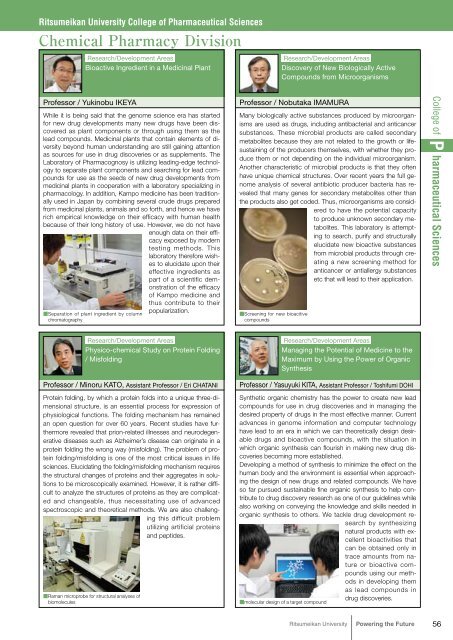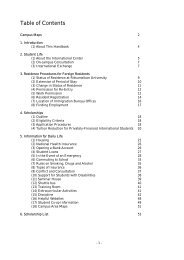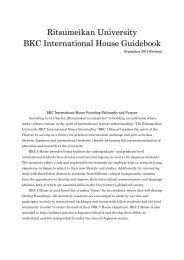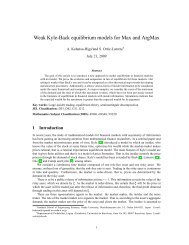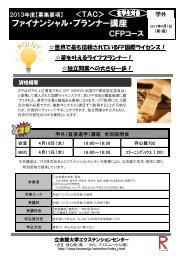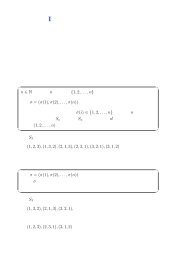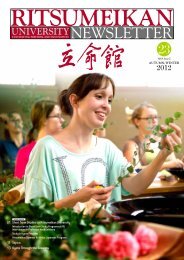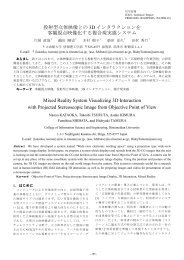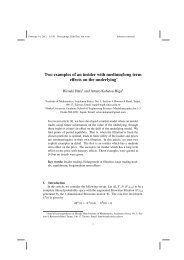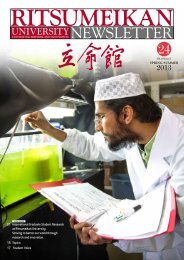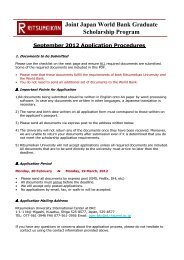Powering the Future - 立命館大学
Powering the Future - 立命館大学
Powering the Future - 立命館大学
Create successful ePaper yourself
Turn your PDF publications into a flip-book with our unique Google optimized e-Paper software.
Ritsumeikan University College of Pharmaceutical Sciences<br />
Chemical Pharmacy Division<br />
Research/Development Areas<br />
Bioactive Ingredient in a Medicinal Plant<br />
Research/Development Areas<br />
Discovery of New Biologically Active<br />
Compounds from Microorganisms<br />
Professor / Yukinobu IKEYA<br />
While it is being said that <strong>the</strong> genome science era has started<br />
for new drug developments many new drugs have been discovered<br />
as plant components or through using <strong>the</strong>m as <strong>the</strong><br />
lead compounds. Medicinal plants that contain elements of diversity<br />
beyond human understanding are still gaining attention<br />
as sources for use in drug discoveries or as supplements. The<br />
Laboratory of Pharmacognosy is utilizing leading-edge technology<br />
to separate plant components and searching for lead compounds<br />
for use as <strong>the</strong> seeds of new drug developments from<br />
medicinal plants in cooperation with a laboratory specializing in<br />
pharmacology. In addition, Kampo medicine has been traditionally<br />
used in Japan by combining several crude drugs prepared<br />
from medicinal plants, animals and so forth, and hence we have<br />
rich empirical knowledge on <strong>the</strong>ir efficacy with human health<br />
because of <strong>the</strong>ir long history of use. However, we do not have<br />
enough data on <strong>the</strong>ir efficacy<br />
exposed by modern<br />
testing methods. This<br />
laboratory <strong>the</strong>refore wishes<br />
to elucidate upon <strong>the</strong>ir<br />
effective ingredients as<br />
part of a scientific demonstration<br />
of <strong>the</strong> efficacy<br />
of Kampo medicine and<br />
thus contribute to <strong>the</strong>ir<br />
popularization.<br />
■Separation of plant ingredient by column<br />
chromatography<br />
Professor / Nobutaka IMAMURA<br />
Many biologically active substances produced by microorganisms<br />
are used as drugs, including antibacterial and anticancer<br />
substances. These microbial products are called secondary<br />
metabolites because <strong>the</strong>y are not related to <strong>the</strong> growth or lifesustaining<br />
of <strong>the</strong> producers <strong>the</strong>mselves, with whe<strong>the</strong>r <strong>the</strong>y produce<br />
<strong>the</strong>m or not depending on <strong>the</strong> individual microorganism.<br />
Ano<strong>the</strong>r characteristic of microbial products is that <strong>the</strong>y often<br />
have unique chemical structures. Over recent years <strong>the</strong> full genome<br />
analysis of several antibiotic producer bacteria has revealed<br />
that many genes for secondary metabolites o<strong>the</strong>r than<br />
<strong>the</strong> products also get coded. Thus, microorganisms are considered<br />
to have <strong>the</strong> potential capacity<br />
to produce unknown secondary metabolites.<br />
This laboratory is attempting<br />
to search, purify and structurally<br />
elucidate new bioactive substances<br />
from microbial products through creating<br />
a new screening method for<br />
anticancer or antiallergy substances<br />
etc that will lead to <strong>the</strong>ir application.<br />
■Screening for new bioacitive<br />
compounds<br />
College of P harmaceutical Sciences<br />
Research/Development Areas<br />
Physico-chemical Study on Protein Folding<br />
/ Misfolding<br />
Professor / Minoru KATO, Assistant Professor / Eri CHATANI<br />
Protein folding, by which a protein folds into a unique three-dimensional<br />
structure, is an essential process for expression of<br />
physiological functions. The folding mechanism has remained<br />
an open question for over 60 years. Recent studies have fur<strong>the</strong>rmore<br />
revealed that prion-related illnesses and neurodegenerative<br />
diseases such as Alzheimer’s disease can originate in a<br />
protein folding <strong>the</strong> wrong way (misfolding). The problem of protein<br />
folding/misfolding is one of <strong>the</strong> most critical issues in life<br />
sciences. Elucidating <strong>the</strong> folding/misfolding mechanism requires<br />
<strong>the</strong> structural changes of proteins and <strong>the</strong>ir aggregates in solutions<br />
to be microscopically examined. However, it is ra<strong>the</strong>r difficult<br />
to analyze <strong>the</strong> structures of proteins as <strong>the</strong>y are complicated<br />
and changeable, thus necessitating use of advanced<br />
spectroscopic and <strong>the</strong>oretical methods. We are also challenging<br />
this difficult problem<br />
utilizing artificial proteins<br />
and peptides.<br />
■Raman microprobe for structural analyses of<br />
biomolecules<br />
Research/Development Areas<br />
Managing <strong>the</strong> Potential of Medicine to <strong>the</strong><br />
Maximum by Using <strong>the</strong> Power of Organic<br />
Syn<strong>the</strong>sis<br />
Professor / Yasuyuki KITA, Assistant Professor / Toshifumi DOHI<br />
Syn<strong>the</strong>tic organic chemistry has <strong>the</strong> power to create new lead<br />
compounds for use in drug discoveries and in managing <strong>the</strong><br />
desired property of drugs in <strong>the</strong> most effective manner. Current<br />
advances in genome information and computer technology<br />
have lead to an era in which we can <strong>the</strong>oretically design desirable<br />
drugs and bioactive compounds, with <strong>the</strong> situation in<br />
which organic syn<strong>the</strong>sis can flourish in making new drug discoveries<br />
becoming more established.<br />
Developing a method of syn<strong>the</strong>sis to minimize <strong>the</strong> effect on <strong>the</strong><br />
human body and <strong>the</strong> environment is essential when approaching<br />
<strong>the</strong> design of new drugs and related compounds. We have<br />
so far pursued sustainable fine organic syn<strong>the</strong>sis to help contribute<br />
to drug discovery research as one of our guidelines while<br />
also working on conveying <strong>the</strong> knowledge and skills needed in<br />
organic syn<strong>the</strong>sis to o<strong>the</strong>rs. We tackle drug development research<br />
by syn<strong>the</strong>sizing<br />
natural products with excellent<br />
bioactivities that<br />
can be obtained only in<br />
trace amounts from nature<br />
or bioactive compounds<br />
using our methods<br />
in developing <strong>the</strong>m<br />
as lead compounds in<br />
drug discoveries.<br />
■molecular design of a target compound<br />
Ritsumeikan University<br />
<strong>Powering</strong> <strong>the</strong> <strong>Future</strong><br />
56


